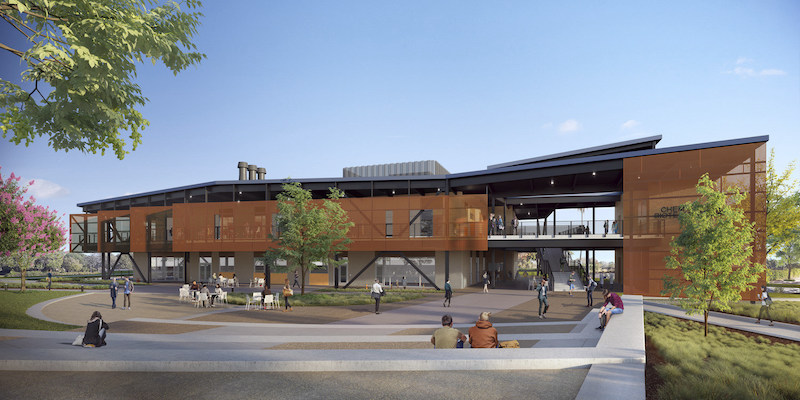MiraCosta Community College is set to receive a new HED-designed Chemistry and Biotechnology laboratory building.
Situated on the northeast quadrant of the Oceanside Campus, the $37.4 million project will include 24,000 sf of STEM instructional space that will feature new chemistry labs and 40-person, flexible classrooms. The building will provide a new, expanded home for the college’s Biotechnology Program.
The project will advance the STEM curriculum to the next level with the help of the facility’s mix of instructional, work, social, and laboratory spaces. The building will be activated through integration with the latest learning technology systems.
SEE ALSO: Lehigh University expands its burgeoning business college
The design takes advantage of the mild Oceanside climate through the incorporation of a ‘big roof’ that provides a weather-protected exterior space for gatherings and interactions. It also will serve as a transition from the building into the quad. Covered and screened porches of varying widths will activate connections to adjoining spaces and provide exterior study and meeting spaces for students.
"This facility takes a 'science on display' approach to stimulating student interest and sharing aspects of the Chemistry and Biotech programs with visitors as well. Large windows and continuous circulation routes allow easy circulation around the building without disturbing classes and labs," said Jennette La Quire, Principal and Project Leader with HED, in a release.
In addition to HED, C.W. Driver is building the project.
Related Stories
| Jun 12, 2014
Austrian university develops 'inflatable' concrete dome method
Constructing a concrete dome is a costly process, but this may change soon. A team from the Vienna University of Technology has developed a method that allows concrete domes to form with the use of air and steel cables instead of expensive, timber supporting structures.
| Jun 11, 2014
5 ways Herman Miller's new office concept rethinks the traditional workplace
Today's technologies allow us to work anywhere. So why come to an office at all? Herman Miller has an answer.
| Jun 9, 2014
6 design strategies for integrating living and learning on campus
Higher education is rapidly evolving. As we use planning and design to help our clients navigate major shifts in culture, technology, and funding, it is essential to focus on strategies that help foster an education that is relevant after graduation. One way to promote relevance is to strengthen the bond between academic disciplines and the campus residential life experience.
| May 29, 2014
7 cost-effective ways to make U.S. infrastructure more resilient
Moving critical elements to higher ground and designing for longer lifespans are just some of the ways cities and governments can make infrastructure more resilient to natural disasters and climate change, writes Richard Cavallaro, President of Skanska USA Civil.
Sponsored | | May 27, 2014
Grim Hall opens the door to fire safety with fire-rated ceramic glass
For the renovation of Lincoln University’s Grim Hall life sciences building into a state-of-the-art computer facility, Tevebaugh Associates worked to provide students and faculty with improved life safety protection. Updating the 1925-era facility's fire-rated doors was an important component of the project.
| May 20, 2014
Kinetic Architecture: New book explores innovations in active façades
The book, co-authored by Arup's Russell Fortmeyer, illustrates the various ways architects, consultants, and engineers approach energy and comfort by manipulating air, water, and light through the layers of passive and active building envelope systems.
| May 19, 2014
What can architects learn from nature’s 3.8 billion years of experience?
In a new report, HOK and Biomimicry 3.8 partnered to study how lessons from the temperate broadleaf forest biome, which houses many of the world’s largest population centers, can inform the design of the built environment.
| May 13, 2014
19 industry groups team to promote resilient planning and building materials
The industry associations, with more than 700,000 members generating almost $1 trillion in GDP, have issued a joint statement on resilience, pushing design and building solutions for disaster mitigation.
| May 11, 2014
Final call for entries: 2014 Giants 300 survey
BD+C's 2014 Giants 300 survey forms are due Wednesday, May 21. Survey results will be published in our July 2014 issue. The annual Giants 300 Report ranks the top AEC firms in commercial construction, by revenue.
| May 10, 2014
How your firm can gain an edge on university projects
Top administrators from five major universities describe how they are optimizing value on capital expenditures, financing, and design trends—and how their AEC partners can better serve them and other academic clients.

















